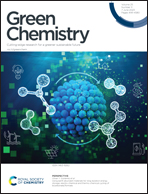Microbial electrosynthesis with Clostridium ljungdahlii benefits from hydrogen electron mediation and permits a greater variety of products†
Abstract
Microbial electrosynthesis (MES) is a very promising technology addressing the challenge of carbon dioxide recycling into organic compounds, which might serve as building blocks for the (bio)chemical industry. However, poor process control and understanding of fundamental aspects such as the microbial extracellular electron transfer (EET) currently limit further developments. In the model acetogen Clostridium ljungdahlii, both direct and indirect electron consumption via hydrogen have been proposed. However, without clarification neither targeted development of the microbial catalyst nor process engineering of MES are possible. In this study, cathodic hydrogen is demonstrated to be the dominating electron source for C. ljungdahlii at electroautotrophic MES allowing for superior growth and biosynthesis, compared to previously reported MES using pure cultures. Hydrogen availability distinctly controlled an either planktonic- or biofilm-dominated lifestyle of C. ljungdahlii. The most robust operation yielded higher planktonic cell densities in a hydrogen mediated process, which demonstrated the uncoupling of growth and biofilm formation. This coincided with an increase of metabolic activity, acetate titers, and production rates (up to 6.06 g L−1 at 0.11 g L−1 d−1). For the first time, MES using C. ljungdahlii was also revealed to deliver other products than acetate in significant amounts: here up to 0.39 g L−1 glycine or 0.14 g L−1 ethanolamine. Hence, a deeper comprehension of the electrophysiology of C. ljungdahlii was shown to be key for designing and improving bioprocess strategies in MES research.



 Please wait while we load your content...
Please wait while we load your content...